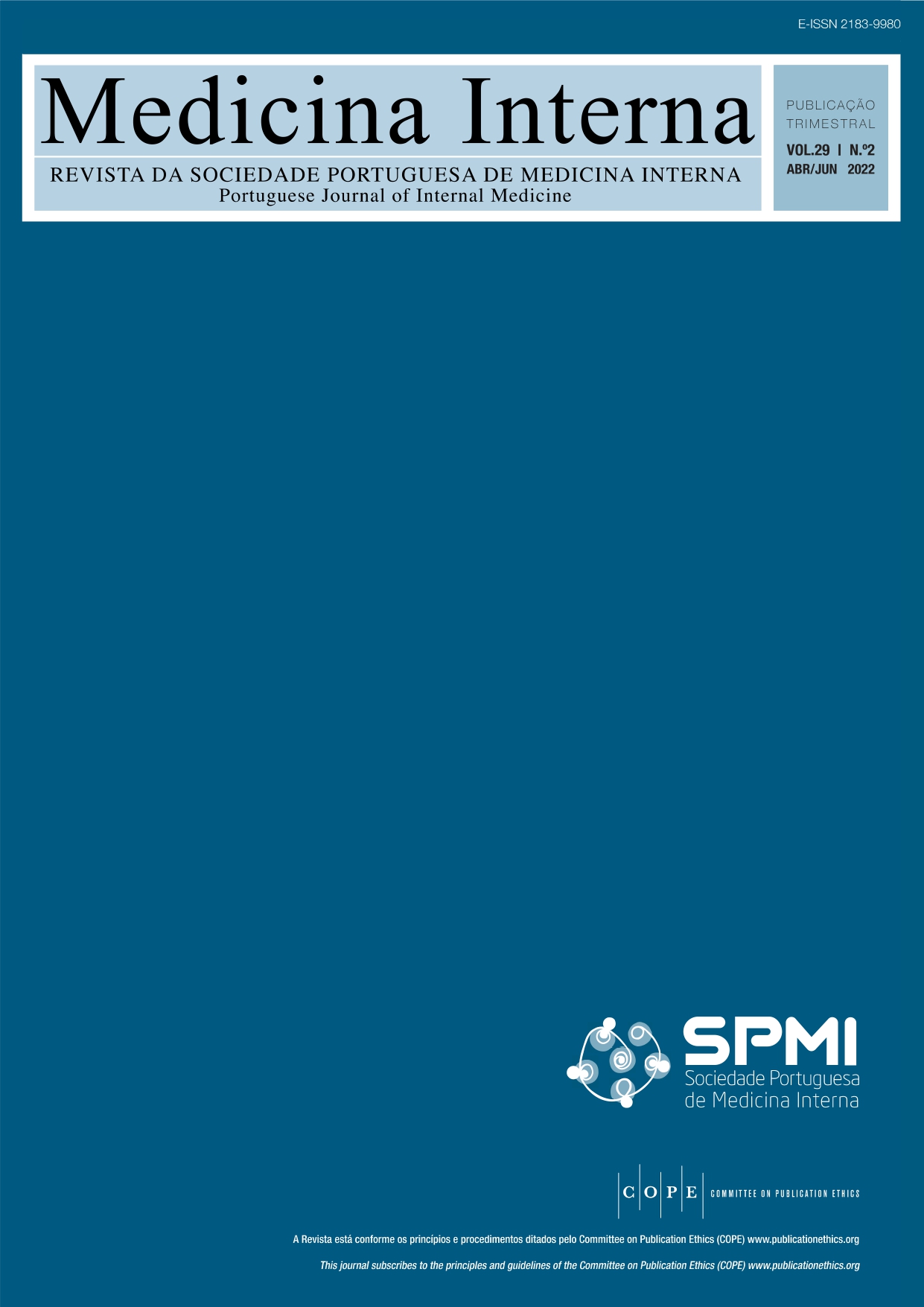Cerebral Venous Thrombosis: 11 Years in a Stroke Unit
DOI:
https://doi.org/10.24950/rspmi.289Keywords:
: Stroke/diagnostic imaging, Venous Thrombosis/diagnostic imagingAbstract
Introduction: Cerebral venous thrombosis (CVT) is a rare type of stroke that is more frequent in young women. This condition presents generally with nonspecific signs and symptoms, and the diagnosis is based on imaging of the brain venous circulation. First-line treatment is anticoagulation Our objective was to characterization of the population diagnosed with CVT in stroke Unit of Setubal hospital.
Methods: Retrospective and descriptive study of CVT cases admitted to our Stroke Unit between 2008 and 2018. Data were collected from the hospital system records and registered in a database. We analyzed demographic, clinical and imaging characteristics and data from the etiological investigation and functional outcome (modified Rankin Scale).
Results: Of the 27 patients included, 21 (78%) were women and the mean age was 43.5 years. The most frequent presentation was headache (96.3%). An oral contraceptive was the most common risk factor identified (44.4%). The initial examination was made by head computed tomography (CT) scan in 23 (85.2%) patients, out of the 20 evocative characteristics of CVT. Diagnosis was confirmed by CT venography or magnetic resonance angiography (MRA). More than 50% of patients had involvement of more than one venous structure. A heparin-based treatment was administered to all patients and the clinical status for discharge was favourable in 25 cases.
Conclusion: CVT mainly affected young women, with oral contraception being a major risk factor. The clinical picture tended to be nonspecific, with headache as the most frequent manifestation. In case of clinical suspicion, a negative head CT does not exclude the diagnosis and the investigation should be continued with MR and MRA. It is important to recognize this pathology, which remains underdiagnosed.
Downloads
References
Saposnik G, Barinagarrementeria F, Brown RDJr, Bushnell CD, Cucchiara B, Cushman M,et al. Diagnosis and management of cerebral venous thrombosis: a statement for healthcare professionals from the American Heart Association/American Stroke Association. Stroke. 2011; 42: 1158-92.
Bousser MG, Ferro JM. Cerebral venous thrombosis: an update. Lancet Neurol. 2007; 6: 162-70.
Santos G, André R, Pereira S, Parreira T, Machado E. Trombose venosa cerebral: análise retrospectiva de 49 casos. Acta Méd Port. 2011;24:21-8.
Ferro JM, Canhão P, Stam J, Bousser MG, Barinagarrementeria F. Prognosis of cerebral vein and dural sinus thrombosis: results of the International Study on Cerebral Vein and Dural Sinus Thrombosis (ISCVT). Stroke. 2004; 35: 664-70.
Coutinho JM, Ferro JM, Canhão P, Barinagarrementeria F, Cantú C, Bousser MG,et al. Cerebral Venous and Sinus Thrombosis in Women. Stroke. 2009; 40: 2356-61.
Coutinho J, de Bruijn SF, Deveber G, Stam J. Anticoagulation for cerebral venous sinus thrombosis. Cochrane Database Syst Rev. 2011; 2011: Cd002005.
de Bruijn SF, de Haan RJ, Stam J. Clinical features and prognostic factors of cerebral venous sinus thrombosis in a prospective series of 59 patients. For The Cerebral Venous Sinus Thrombosis Study Group. J Neurol Neurosurg Psychiatry. 2001;70:105-08.
Ferro JM, Bousser MG, Canhão P, Coutinho JM, Crassard I, Dentali F, et al. European Stroke Organization guideline for the diagnosis and treatment of cerebral venous thrombosis - endorsed by the European Academy of Neurology. Eur J Neurol. 2017;24:1203-13. doi: 10.1111/ene.13381
Kernan WN, Ovbiagele B, Black HR, Bravata DM, Chimowitz MI, Ezekowitz MD, et al. Guidelines for the prevention of stroke in patients with stroke and transient ischemic attack: a guideline for healthcare professionals from the American Heart Association/American Stroke Association. Stroke. 2014; 45: 2160-236.
Borhani Haghighi A, Edgell RC, Cruz-Flores S, Feen E, Piriyawat P, Vora N, et al. Mortality of cerebral venous-sinus thrombosis in a large national sample. Stroke. 2012;43:262-4.
Stam J. Thrombosis of the Cerebral Veins and Sinuses. New Engl J Med. 2005;352:1791-8.
Kimber J. Cerebral venous sinus thrombosis. QJM. 2002;95:137-42. doi: 10.1093/qjmed/95.3.137.
Bousser MG, Chiras J, Bories J, Castaigne P. Cerebral venous thrombosis-- -a review of 38 cases. Stroke. 1985;16:199-213.
Renowden S. Cerebral venous sinus thrombosis. Eur Radiol. 2004;14:215- 26.
Ashjazadeh N, Borhani Haghighi A, Poursadeghfard M, Azin H. Cerebral venous-sinus thrombosis: a case series analysis. Iran J Med Sci. 2011; 36: 178-82.
Martinelli I, Sacchi E, Landi G, Taioli E, Duca F, Mannucci PM. High risk of cerebral-vein thrombosis in carriers of a prothrombin-gene mutation and in users of oral contraceptives. N Engl J Med. 1998; 338: 1793-7. doi: 10.1056/NEJM199806183382502.
de Bruijn SF, Stam J, Koopman MM, Vandenbroucke JP. Case-control study of risk of cerebral sinus thrombosis in oral contraceptive users and in [correction of who are] carriers of hereditary prothrombotic conditions. The Cerebral Venous Sinus Thrombosis Study Group. BMJ. 1998; 316: 589-92.
Ferro JM, Canhão P, Bousser MG, Stam J, Barinagarrementeria F. Cerebral vein and dural sinus thrombosis in elderly patients. Stroke. 2005; 36: 1927-32.
Marjot T, Yadav S, Hasan N, Bentley P, Sharma P. Genes associated with adult cerebral venous thrombosis. Stroke. 2011;42:913-8. doi: 10.1161/ STROKEAHA.110.602672
Downloads
Published
How to Cite
Issue
Section
Categories
License
Copyright (c) 2022 Medicina Interna

This work is licensed under a Creative Commons Attribution 4.0 International License.
Copyright (c) 2023 Medicina Interna






